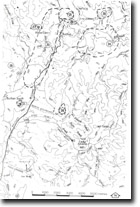8523 (8522)-30 Heaths Quarry and Limonite Quarry
Sites 8523 (8522) 16 to 30 - The Buchan/Murrindal Limestone Basin
This information has been developed from the publications:
|
Location: | 035425. Heaths Quarry and Limonite Quarry are located on Tara Creek, South Buchan. |  8523 (8522)-20 to 8523-21, 23-24, 26-31 |
Abstract: | Biohermal facies in Buchan Caves Limestone and limonite replacement of Buchan Caves Limestone. | |
Access: | Via the eastern extension of North Boundary Road. | |
Ownership: | Private land. | |
Geology: | Heaths Quarry is composed of limestone almost entirely made up of stromatoporoid colonies with less significant contributions from rugose and tabulate corals (Acanthophyllum, Xystriphyllum, Favosites, Gephuropora and Thamnopora) and algae. In some places an admixture of crinoid stems and rare brachiopod fragments occur. Limonite Quarry - the origin of the limonite is somewhat unclear. However the most recent investigations suggest that the limonite represents a gossan developed over a conformable pyrite body dipping west at approximately 45 degrees. The best exposures of limonite are in the disused quarry, where hard, secondary enriched, sometimes botryoidal limonite overlies friable pale brown to red ironstone. Limestone fragments in various stages of ferruginization, together with silicified limestone, in which only the matrix has been replaced by silica occur. Thin quartz veins and nodules of hallo site are also present. | |
Significance: | Regional. The largest and best exposed biohermal limestone deposit in the Buchan Caves Limeston together with the best exposure of limonite gossan development in the Buchan area. | |
Management: | The geological display at both localities would be enhanced by occasional working, exposing quarry faces. | |
References: | Ripper, E.A. 1937. 'On the Stromatoporoids of the Buchan District, Victoria', Proc. R. Soc. Vict., 50 (N.S.) 1 :11-38. Talent, J.A. 1956. 'Notes on Middle Palaeozoic Stratigraphy and diastrophism in Eastern Victoria', Min. geol. Journ., 6 :57-58. Tiechert, C. and Talent, J.A. 1958. 'Geology of the Buchan area, East Gippsland', Mem. geol. Surv. Vict., 21: 1-56. Bain, A.D.N. 1958. 'Buchan Limonite Deposit', Min. and Geol. Journ. (Vict). 6(2) : 32. Bowen, K.G. 1970. 'Limonite at Buchan', Min. geol. J. Vict., 6(6) :71-79. | |


